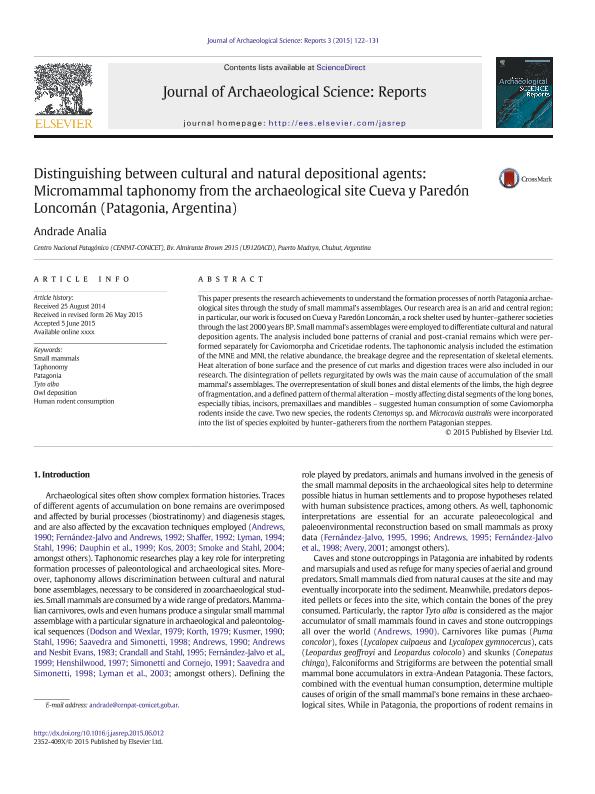Mostrar el registro sencillo del ítem
dc.contributor.author
Andrade, Analia

dc.date.available
2016-05-09T20:29:15Z
dc.date.issued
2015-06
dc.identifier.citation
Andrade, Analia; Distinguishing between cultural and natural depositional agents: Micromammal taphonomy from the archaeological site Cueva y Paredón Loncomán (Patagonia, Argentina); Elsevier; Journal of Archaeological Science: Reports; 3; 6-2015; 122-131
dc.identifier.issn
2352-409X
dc.identifier.uri
http://hdl.handle.net/11336/5593
dc.description.abstract
This paper presents the research achievements to understand the formation processes of north Patagonia archaeological sites through the study of small mammal's assemblages. Our research area is an arid and central region; in particular, our work is focused on Cueva y Paredón Loncomán, a rock shelter used by hunter–gatherer societies through the last 2000 years BP. Small mammal's assemblages were employed to differentiate cultural and natural deposition agents. The analysis included bone patterns of cranial and post-cranial remains which were performed separately for Caviomorpha and Cricetidae rodents. The taphonomic analysis included the estimation of the MNE and MNI, the relative abundance, the breakage degree and the representation of skeletal elements. Heat alteration of bone surface and the presence of cut marks and digestion traces were also included in our research. The disintegration of pellets regurgitated by owls was the main cause of accumulation of the small mammal's assemblages. The overrepresentation of skull bones and distal elements of the limbs, the high degree of fragmentation, and a defined pattern of thermal alteration – mostly affecting distal segments of the long bones, especially tibias, incisors, premaxillaes and mandibles – suggested human consumption of some Caviomorpha rodents inside the cave. Two new species, the rodents Ctenomys sp. and Microcavia australis were incorporated into the list of species exploited by hunter–gatherers from the northern Patagonian steppes.
dc.format
application/pdf
dc.language.iso
eng
dc.publisher
Elsevier

dc.rights
info:eu-repo/semantics/openAccess
dc.rights.uri
https://creativecommons.org/licenses/by-nc-nd/2.5/ar/
dc.subject
Small Mammals
dc.subject
Taphonomy
dc.subject
Patagonia
dc.subject
Tyto Alba
dc.subject
Owl Deposition
dc.subject
Human Rodent Consumption
dc.subject.classification
Arqueología

dc.subject.classification
Historia y Arqueología

dc.subject.classification
HUMANIDADES

dc.title
Distinguishing between cultural and natural depositional agents: Micromammal taphonomy from the archaeological site Cueva y Paredón Loncomán (Patagonia, Argentina)
dc.type
info:eu-repo/semantics/article
dc.type
info:ar-repo/semantics/artículo
dc.type
info:eu-repo/semantics/publishedVersion
dc.date.updated
2016-04-28T14:50:10Z
dc.journal.volume
3
dc.journal.pagination
122-131
dc.journal.pais
Países Bajos

dc.journal.ciudad
Amsterdam
dc.description.fil
Fil: Andrade, Analia. Consejo Nacional de Investigaciones Científicas y Técnicas. Centro Nacional Patagónico; Argentina
dc.journal.title
Journal of Archaeological Science: Reports
dc.relation.alternativeid
info:eu-repo/semantics/altIdentifier/url/http://www.sciencedirect.com/science/article/pii/S2352409X15300316
dc.relation.alternativeid
info:eu-repo/semantics/altIdentifier/doi/http://dx.doi.org/10.1016/j.jasrep.2015.06.012
dc.relation.alternativeid
info:eu-repo/semantics/altIdentifier/doi/10.1016/j.jasrep.2015.06.012
Archivos asociados
